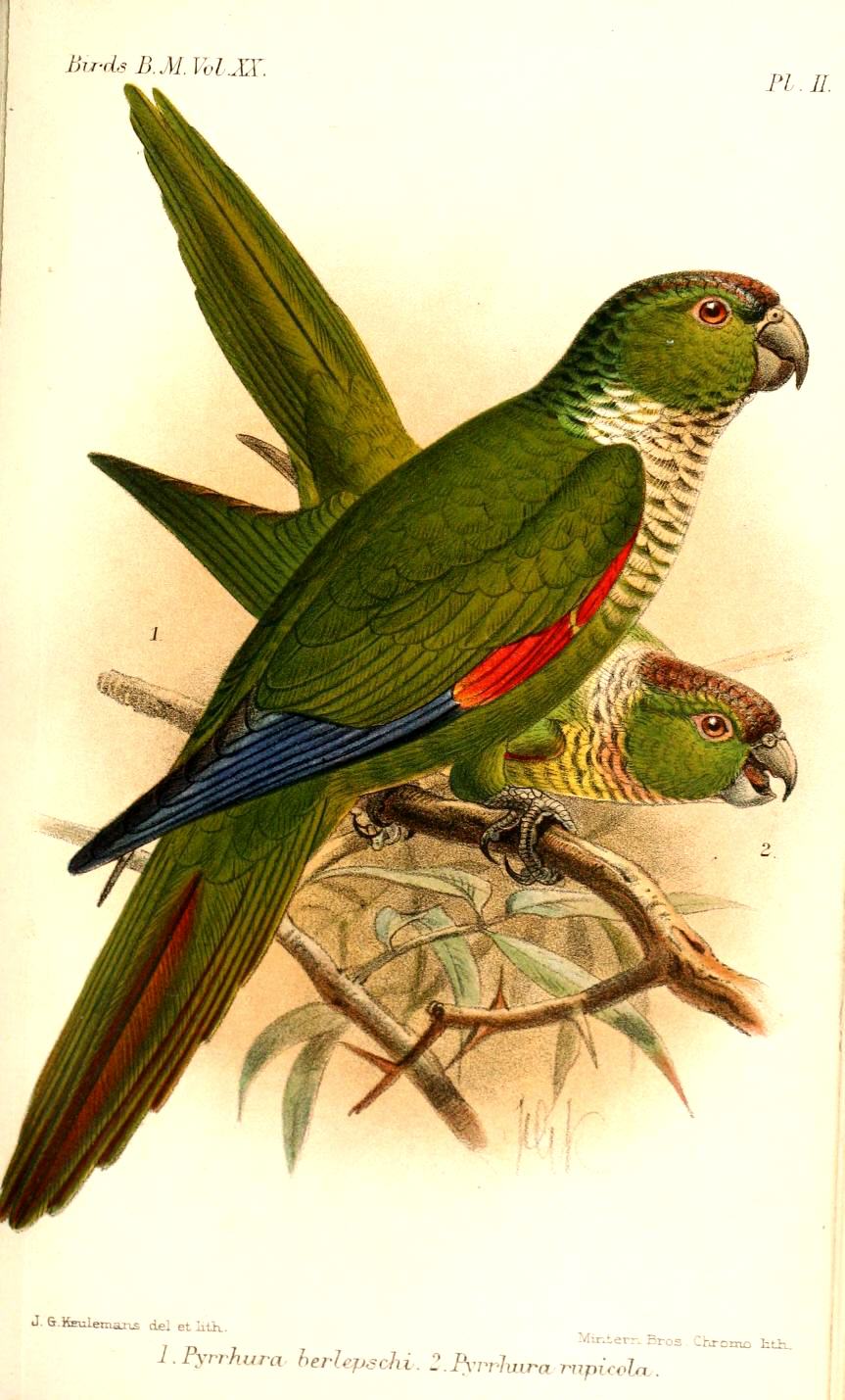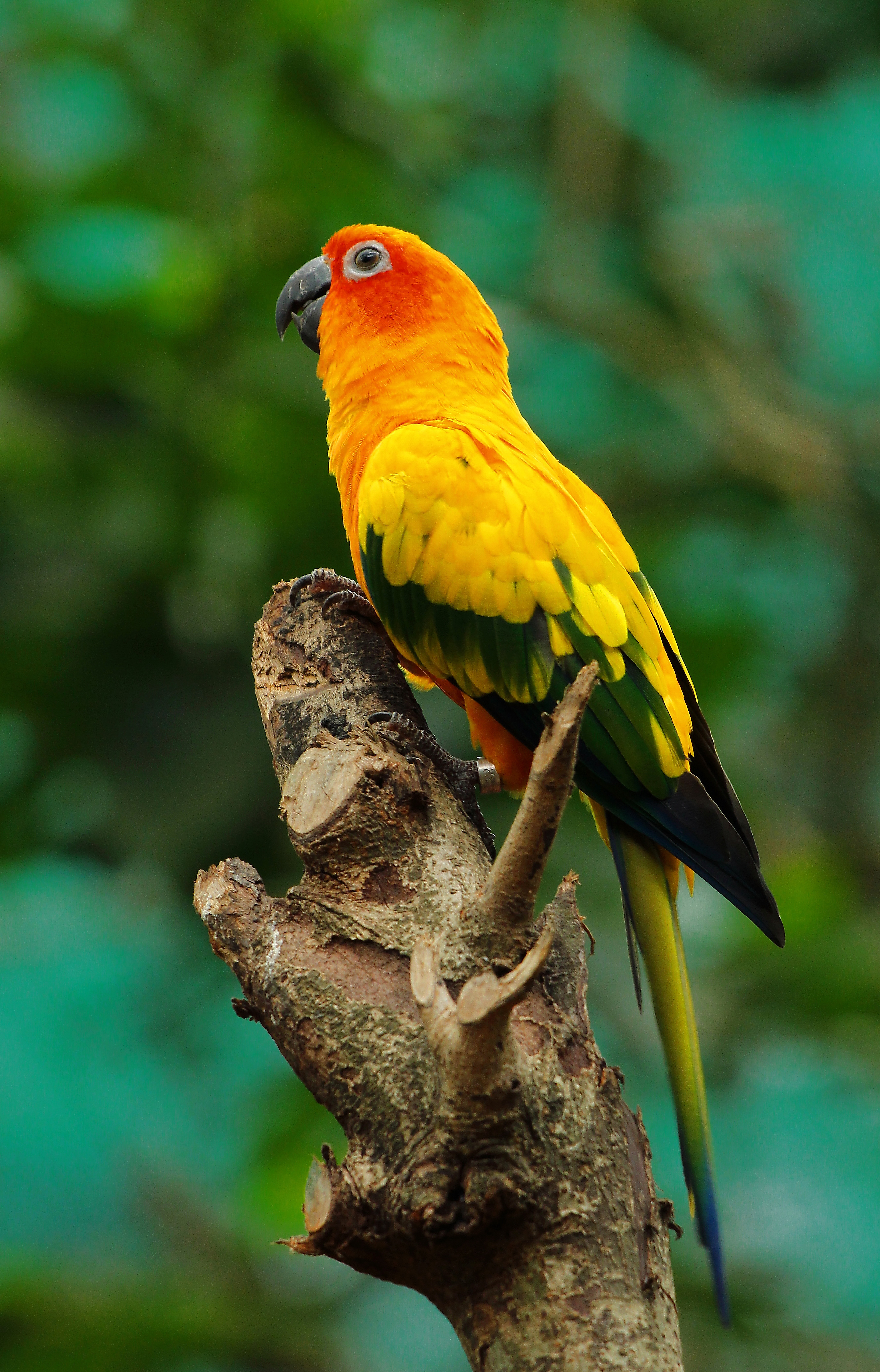|
Pyrrhura
''Pyrrhura'' (Greek Red/Fire Tail) is a genus of parrots in the Arini tribe. They occur in tropical and subtropical South America and southern Central America (Panama and Costa Rica). Most are restricted to humid forest and adjacent habitats, but one species, the blaze-winged parakeet, prefers deciduous or gallery woodland, and another, the Pfrimer's parakeet, is restricted to dry regions. Some species are highly endangered. Depending on the species, the total length range from . All have long, pointed tails, a mainly green plumage, and a relatively narrow, dark greyish to white eye-ring. Many have scaly or barred chest-patterns and a whitish, pale grey, buff or reddish ear-patch. They typically move around in small, noisy flocks, flying swiftly at or below canopy level. Once settled in a tree they tend to be silent (especially if aware of danger) and difficult to spot. They nest in a tree-crevice. Some species are popular in aviculture, where they are commonly referred ... [...More Info...] [...Related Items...] OR: [Wikipedia] [Google] [Baidu] |
Green-cheeked Parakeet
The green-cheeked parakeet or green-cheeked conure (''Pyrrhura molinae'') is a small parrot of the genus ''Pyrrhura'', which is part of a long-tailed group of the New World parrot subfamily Arinae. The term ''conure'' is often used for this parrot and its relatives in aviculture. It is native to the forests of Central and South America. Description The green-cheeked parakeet is typically long and weighs 60 to 80 g. It is mainly green, with a brown/black/grey crown, white periophthalmic rings, green cheeks, blue primary wing feathers, a grey beak, and a long, mainly maroon tail. It has short transverse striations on its breast and a red abdominal area. Males and females have a mostly identical external appearance. The only truly verifiable way to identify the gender of a green-cheeked parakeet is through a DNA test. Taxonomy The green-cheeked parakeet has six subspecies:Forshaw (2006). plate 85. * ''Pyrrhura molinae'', (Massena & Souance 1854) ** ''P. m. australis'', Todd 1 ... [...More Info...] [...Related Items...] OR: [Wikipedia] [Google] [Baidu] |
Painted Parakeet
The painted parakeet (''Pyrrhura picta''), more commonly known as the painted conure in aviculture, is a species of bird in the family Psittacidae, the true parrots. Its taxonomy is highly complex, and has undergone significant changes in recent years. As here defined, it is restricted to forests in northern South America (north of the Amazon River) and Panama. Some of the taxa here included in the painted parakeet are highly endangered. Taxonomy and distribution Traditionally, the painted parakeet included the Santarém parakeet (''P. amazonum''), Bonaparte's parakeet (''P. lucianii'') and rose-fronted parakeet (''P. roseifrons'') as subspecies. Following a review in 2002, it was recommended treating these as separate species.Joseph, L. (2002). ''Geographic variation, taxonomy and distribution of some Amazonian Pyrrhura parakeets.'' Ornitologia Neotropical 13(4): 337-363. In 2006, a study based on mtDNA confirmed that the "traditional" painted parakeet was polyphyletic, as ... [...More Info...] [...Related Items...] OR: [Wikipedia] [Google] [Baidu] |
Crimson-bellied Parakeet
The crimson-bellied parakeet (''Pyrrhura perlata''), more commonly known as the crimson-bellied conure in aviculture, is a species of parrot in the family Psittacidae. Taxonomy Its taxonomic history is potentially confusing. It was formerly known as ''Pyrrhura rhodogaster'', but following a review it was discovered that the type specimen for ''P. perlata'', long believed to belong to the closely related pearly parakeet, actually was a juvenile crimson-bellied parakeet. Consequently, ''P. perlata'' was transferred to this species, while ''P. rhodogaster'' became a junior synonym. Description ''Pyrrhura perlata'' adults are partly green in colour. They have yellow/green cheeks, turning to blue on lower cheeks. The breast is brown with pale off-white and dark brown barring. Crimson-bellied parakeets have a blue collar around their hindnecks, varying with each bird. They have red bend of wing, lesser underwing coverts; blue thighs to tail coverts The tail is brown/red. ''Pyrrhur ... [...More Info...] [...Related Items...] OR: [Wikipedia] [Google] [Baidu] |
Maroon-bellied Parakeet
__NOTOC__ The maroon-bellied parakeet (''Pyrrhura frontalis'') is a small parrot found from southeastern Brazil to north-eastern Argentina, including eastern Paraguay and Uruguay. It is also known as the reddish-bellied parakeet, and in aviculture it is usually referred to as the maroon-bellied conure, reddish-bellied conure or brown-eared conure. Taxonomy It has been suggested that the reddish-bellied parakeet should include the blaze-winged parakeet (''P. devillei'') as a subspecies based on intermediate specimens from Paraguay. But such hybrids are not common in the wild and the two populations generally maintain their integrity; recent sources are undecided on whether to treat them as one species or two. Description These birds range from 25 to 28 cm (10–11 in), and are primarily green, with a maroon patch on the belly, a "scaly" yellow-green-barred breast and sides of neck, a whitish ear-patch often tinged brown, and a maroon undertail. The specific name ''fron ... [...More Info...] [...Related Items...] OR: [Wikipedia] [Google] [Baidu] |
Pfrimer's Parakeet
Pfrimer's parakeet (''Pyrrhura pfrimeri'') is a non-migratory species within the parrot family ''Psittacidae''. It also is known as Pfrimer's conure, Goias parakeet, and maroon-faced conure. The Pfrimer's parakeet has been qualified as endangered by the IUCN and BirdLife International since 2007. It is endemic to the Goiás and Tocantins regions of Brazil. It is mainly found within a belt of dry deciduous and semi-deciduous areas of the Caatinga forest.Handbook of the Birds of the World https://www.hbw.com/species/goias-parakeet-pyrrhura-pfrimeri It was considered a subspecies of the white-eared parakeet, as ''Pyrrhura leucotis pfrimeri''. The split was based on range, differences in habitat and distinctive differences in plumage (it is the only member of the P. leucotis complex where the pale patch on the ear-coverts is greatly reduced). A recent study based on mtDNA has confirmed its status as a distinct species. The population of Pfrimer's parakeet is currently decreasing, ... [...More Info...] [...Related Items...] OR: [Wikipedia] [Google] [Baidu] |
White-eared Parakeet
The white-eared parakeet or maroon-faced parakeet (''Pyrrhura leucotis'') is a small parrot belonging to the genus ''Pyrrhura''. As here defined, it is Endemism, endemic to Atlantic Forest in eastern Brazil. The Venezuelan parakeet, Venezuelan, grey-breasted parakeet, grey-breasted and Pfrimer's parakeets were formerly classed as subspecies of this bird but are increasingly treated as separate species. Description It is 21–22 centimetres long. The plumage is mostly green. The chest has dark grey and whitish scaling on a green background, and the rump and belly are Maroon (color), maroon. The face and throat are dark maroon, the forehead is bluish and there is a whitish ear-patch. The long, graduated tail has a red underside. The bird has a sharp call which is repeated three or four times. The grey-breasted parakeet is very similar but is proportionally larger-headed, has a longer bill with a deeper mandible, lacks blue to the forecrown (as do the occasional white-eared parakee ... [...More Info...] [...Related Items...] OR: [Wikipedia] [Google] [Baidu] |
Conure
Conures are a diverse, loosely defined group of small to medium-sized parrots. They belong to several genera within a long-tailed group of the New World parrot subfamily Arinae. The term "conure" is used primarily in bird keeping, though it has appeared in some scientific journals. The American Ornithologists' Union uses the generic term ''parakeet'' for all species elsewhere called ''conure'', though Joseph Forshaw, a prominent Australian ornithologist, uses ''conure''. Description Conures are either large parakeets or small parrots found in the Western Hemisphere. They are analogous in size and way of life to Afro-Eurasia's rose-ringed parakeets or the Australian parakeets. All living conure species live in Central and South America. The extinct ''Conuropsis carolinensis'', or Carolina parakeet was an exception. Conures are often called the clowns of the parrot world due to their constant attention seeking behavior including hanging upside-down and swaying ba ... [...More Info...] [...Related Items...] OR: [Wikipedia] [Google] [Baidu] |
Blaze-winged Parakeet
The blaze-winged parakeet (''Pyrrhura devillei''), more commonly known as the blaze-winged conure in aviculture, is a species of parrot found in wooded habitats in the Pantanal region of Brazil, Bolivia and Paraguay. It remains locally fairly common, but has suffered due to extensive habitat destruction within its relatively small range, and has therefore been uplisted to near-threatened by BirdLife International in 2009. The type specimen is labelled Bolivia, but due to shifting borders it is now believed to be from Paraguay. It has often been considered a subspecies of the maroon-bellied parakeet based on apparent hybrids from Paraguay, but – as far as known – the two generally maintain their integrity, and are recent sources are undecided on whether to treat them as one species or two. They resemble each other, but the blaze-winged parakeet has a dusky crown and red "shoulder" and underwing coverts A covert feather or tectrix on a bird is one of a set of feathers, calle ... [...More Info...] [...Related Items...] OR: [Wikipedia] [Google] [Baidu] |
Ochre-marked Parakeet
The ochre-marked parakeet (''Pyrrhura cruentata'') is a species of parrot native to Brazil. It is also known as blue-throated parakeet and red-eared conure in English and ''tiriba-grande'', ''tiriba'', ''cara-suja'' and ''fura-mato-grande'' in Portuguese. It is listed as Vulnerable (VU) on the IUCN Red List. Description This colourful parakeet is a predominantly green bird with conspicuous red patches on its belly, rump, and shoulder and before, below and behind the eye. The crown is dark brown to blackish, becoming mottled on the nape of the neck, and there is a broad, bright blue bib on the chest, extending thinly around the back of the neck to form a faint collar. The outer primaries are blue, and the tail is olive-green above, and brownish red below. Habitat It inhabits the canopy of lowland humid forest and edge, occasionally up to 960 meters. It has also been recorded in small clearings and selectively logged forest, and persists (or at least persisted) in agricultural are ... [...More Info...] [...Related Items...] OR: [Wikipedia] [Google] [Baidu] |
Bird Species New To Science Described In The 2000s
This page details the bird species described as new to science in the years 2000 to 2010: Summary statistics Number of species described per year Countries with high numbers of newly described species * Brazil * Colombia * Peru * Indonesia The birds, year-by-year 2000 * Foothill elaenia, ''Myiopagis olallai'' :Coopmans, P. & Krabbe, N. (2000) A new species of flycatcher (Tyrannidae: Myiopagis) from eastern Ecuador and eastern Peru ''Wilson Bulletin'' 112: 305–312 * Caatinga antwren, ''Herpsilochmus sellowi'' :Whitney, B.M.; Pacheco, J.F.; Buzzetti, D.R.C. & Parrini, R. (2000) Systematic revision and biogeography of the Herpsilochmus pileatus complex, with description of a new species from northeastern Brazil ''Auk'' 117: 869–891 * Taiwan bush-warbler, ''Bradypterus alishanensis'' :Rasmussen, P.C.; Round, P.D.; Dickinson, E.C. & Rozendaal, F.G. (2000) A new bush-warbler (Sylviidae, Bradypterus) from Taiwan ''The Auk'' 117: 279–289 * Scarlet-banded barbet or Wallac ... [...More Info...] [...Related Items...] OR: [Wikipedia] [Google] [Baidu] |
Neotropical Parrots
The neotropical parrots or New World parrots comprise about 150 species in 32 genera found throughout South and Central America, Mexico, the Caribbean islands and (formerly) the southern United States. Among them are some of the most familiar and iconic parrots, including the blue and gold macaw, sun conure, and yellow-headed amazon. The parrots of the New World have been known to Europeans since Columbus remarked upon them in his journal in 1492. Systematic descriptions of the birds were first available in German naturalist Georg Marcgraf's ''Historia Naturalis Brasiliae'' published in 1648, and English naturalist Mark Catesby's two-volume ''Natural History of Carolina, Florida and the Bahama Islands'' published in London in 1731 and 1743. Several species and one genus have become extinct in recent centuries. A second genus is extinct in the wild. Over a third of the extant species are classified as threatened by the IUCN. A few of these are in imminent danger of extinctio ... [...More Info...] [...Related Items...] OR: [Wikipedia] [Google] [Baidu] |





